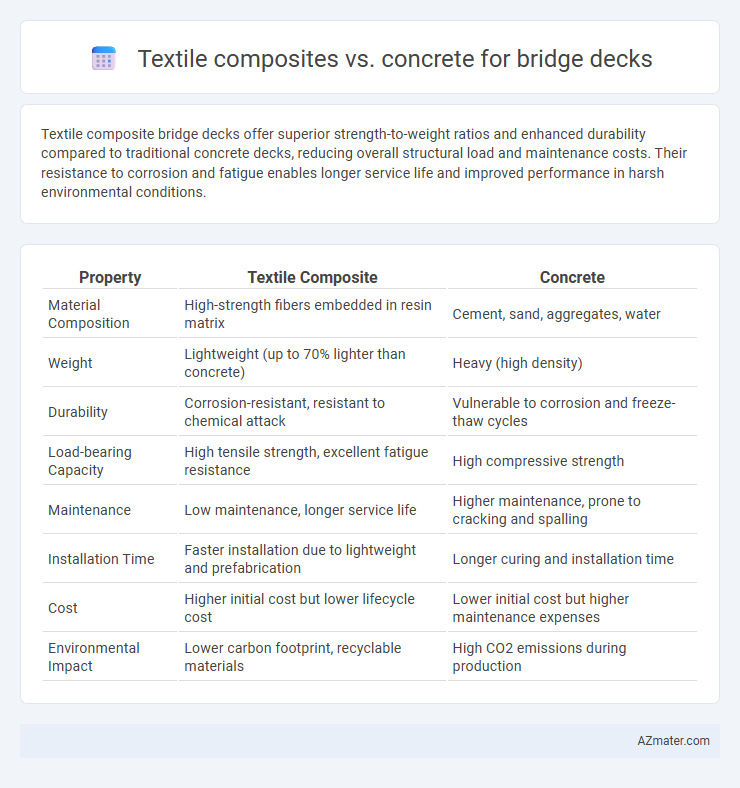Textile composite bridge decks offer superior strength-to-weight ratios and enhanced durability compared to traditional concrete decks, reducing overall structural load and maintenance costs. Their resistance to corrosion and fatigue enables longer service life and improved performance in harsh environmental conditions.
Table of Comparison
| Property | Textile Composite | Concrete |
|---|---|---|
| Material Composition | High-strength fibers embedded in resin matrix | Cement, sand, aggregates, water |
| Weight | Lightweight (up to 70% lighter than concrete) | Heavy (high density) |
| Durability | Corrosion-resistant, resistant to chemical attack | Vulnerable to corrosion and freeze-thaw cycles |
| Load-bearing Capacity | High tensile strength, excellent fatigue resistance | High compressive strength |
| Maintenance | Low maintenance, longer service life | Higher maintenance, prone to cracking and spalling |
| Installation Time | Faster installation due to lightweight and prefabrication | Longer curing and installation time |
| Cost | Higher initial cost but lower lifecycle cost | Lower initial cost but higher maintenance expenses |
| Environmental Impact | Lower carbon footprint, recyclable materials | High CO2 emissions during production |
Introduction to Bridge Deck Materials
Textile composites offer high strength-to-weight ratios and corrosion resistance, making them an innovative alternative to traditional concrete for bridge decks. Concrete remains widely used due to its durability, compressive strength, and cost-effectiveness, despite susceptibility to cracking and corrosion of steel reinforcements. Advances in textile composite technology provide enhanced flexibility and reduced maintenance, positioning them as a sustainable solution in modern bridge construction.
Overview of Textile Composite Decking
Textile composite decking for bridge decks offers enhanced corrosion resistance, reduced weight, and increased durability compared to traditional concrete decks. These composites utilize high-strength fibers such as carbon or glass embedded in polymer matrices, resulting in superior tensile strength and fatigue performance. Their lightweight nature reduces bridge load requirements and eases installation, making textile composites an efficient alternative for modern infrastructure projects.
Concrete as a Traditional Bridge Deck Material
Concrete remains the predominant material for bridge decks due to its proven durability, high compressive strength, and ability to withstand heavy traffic loads over extended periods. Its widespread use is supported by established construction techniques and cost-effectiveness in large-scale infrastructure projects. Despite emerging alternatives like textile composites offering lightweight advantages, concrete's structural reliability and extensive performance data ensure its continued preference in bridge deck applications.
Comparative Structural Performance
Textile composite bridge decks exhibit superior tensile strength and corrosion resistance compared to traditional concrete decks, enhancing durability in harsh environments. Their lightweight nature reduces dead load, improving seismic performance and enabling longer spans without additional support. Concrete decks offer higher compressive strength and stiffness, providing robust load-bearing capacity but are more susceptible to cracking and chloride-induced deterioration over time.
Durability and Longevity
Textile composite bridge decks exhibit superior durability compared to traditional concrete due to their high resistance to corrosion, fatigue, and chemical exposure, significantly extending service life in harsh environments. Concrete decks, although strong and cost-effective initially, often suffer from cracking, spalling, and reinforcement corrosion, leading to frequent maintenance and reduced longevity. Advanced textile composites enable lightweight, resilient bridge decks that maintain structural integrity over decades, minimizing lifecycle costs and maximizing durability in infrastructure applications.
Weight and Load-Bearing Considerations
Textile composite bridge decks offer significant weight reduction compared to traditional concrete, improving load distribution and reducing dead load on supporting structures. Their high tensile strength and corrosion resistance enhance durability, enabling longer spans and increased load-bearing capacity without compromising structural integrity. Concrete decks, while heavy, provide compressive strength and stiffness crucial for heavy vehicular loads, but their mass contributes to increased foundation and support requirements.
Installation and Construction Methods
Textile composite bridge decks offer rapid installation with lightweight prefabricated panels that reduce on-site labor and minimize traffic disruption, contrasting with the bulky, heavy materials required for traditional concrete decks. Construction of textile composite decks involves modular assembly techniques and can be performed with less specialized equipment, whereas concrete decks demand extensive formwork, curing times, and heavy machinery for casting and finishing. These distinctions result in textile composites enabling faster project timelines and increased flexibility in bridge deck design and maintenance compared to conventional concrete methods.
Maintenance Requirements and Costs
Textile composite bridge decks require significantly less maintenance than traditional concrete decks due to their resistance to corrosion and lightweight properties, reducing repair frequency and associated labor costs. Concrete decks often experience cracking and spalling, necessitating regular inspections, patching, and surface treatments that increase long-term maintenance expenses. The initial higher cost of textile composites is offset by their durability and lower life-cycle costs, offering a cost-efficient solution for bridge deck construction.
Environmental Impact and Sustainability
Textile composites in bridge decks significantly reduce environmental impact by lowering carbon emissions due to their lightweight properties, which reduce the need for heavy machinery and transportation fuel. Unlike traditional concrete, textile composites are resistant to corrosion and require less maintenance, extending the service life and minimizing resource consumption over time. This sustainable alternative supports circular economy principles by enabling recyclability and reducing material waste compared to the energy-intensive production of concrete.
Future Trends in Bridge Deck Materials
Textile composites are emerging as a promising alternative to traditional concrete for bridge decks due to their superior strength-to-weight ratio, corrosion resistance, and reduced maintenance costs. Advances in nanotechnology and sustainable materials enhance the durability and environmental benefits of textile composites, positioning them as a key material in future bridge design. Integration of smart sensors within textile composites enables real-time structural health monitoring, driving innovations in predictive maintenance and safety optimization for modern bridge infrastructure.

Infographic: Textile composite vs Concrete for Bridge deck
 azmater.com
azmater.com